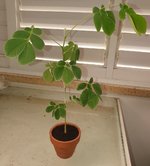Got a small pack of a dozen Samanea Saman (Monkeypod/Rain tree) seeds a month and a half ago and and planted six of them in different soil batches to see what'd work (if anything).
2 never sprouted, 4 did, and boy do these things grow a lot faster than I thought they would.
Any suggestions/recommendations moving forward?
I have one remaining of the few that I planted initially. There doesn't seem to be a whole lot of information out there about growing them as bonsai.
Some suggestions based on what I've learned so far:
1. If you want some movement in the trunk or a branch, wire it while it's still green and flexible. The trunk/branches do not stay flexible for long.
2. Squirrels find the young saplings to be irresistibly delicious. So, it would be wise to do something to try to protect them until they're at least a few years old. (Like I said, I planted a few of them and only one survives. Guess what happened to the others...)
3. When asking for advice on a forum, it's probably best to use Monkeypod for the common name or just use the scientific name. Avoid calling it a rain tree, as the Brazilian rain tree (different genus & species) is much more commonly grown as bonsai and people are likely to mistakenly assume that's what you're talking about and probably give you advice that may or may not be applicable.
4. They tend to struggle indoors during the winter. I haven't sorted out precisely what the issues are. They probably don't like the low humidity. I keep them under lights, but maybe it's not enough (or too much) or maybe the transpiration rate is different enough that they're over- or underwatered? I've noticed that they do well during the first part of the fall/winter, but struggle by the time we get to March/April. Often, some of the leaves will turn white and they may drop some or all of their leaves. Don't give up though. I thought mine was probably dead, but put it out in the garden in the spring anyway. I'd just about reached the point of giving it up for dead when it finally started pushing out new growth. It bounced back just fine in the summer and is growing really well now.
5. When you first bring them indoors for the winter, the leaves may stay stuck in their nighttime position (folded, to permit rain to pass through the canopy unhindered) all day long for a couple of weeks until they adjust to the new light levels and circadian rhythm.
6. Like any tropical tree, bring it indoors when the weather starts dipping down below 50 degrees F at night.




